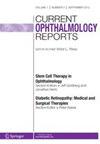Intrastromal descemet membrane transplantation in eyes with advanced keratoconus
IF 0.9
Q4 OPHTHALMOLOGY
引用次数: 0
Abstract
Background. To report the outcomes of intrastromal Descemet membrane (DM) transplantation in corneas with advanced keratoconus. Materials and methods. Three eyes of 3 patients presented with advanced, progressive keratoconus. None of the eyes had prior UV-crosslinking or any other ocular surgery performed. All eyes had a donor DM implanted into a mid-stromal pocket under local anesthesia, and clinical outcomes were evaluated at 12 months after surgery. Results. To the best of our knowledge, this is the first report of DM transplantation performed in cases of advanced keratoconus. At 12 months after surgery, the DM graft was well positioned and barely visible within the recipient stroma, and all corneas were clear. None of the eyes showed signs of keratoconus progression throughout the follow-up period. No significant changes were observed in uncorrected (UCVA) and best contact lens corrected visual acuity (BCLCVA), central endothelial cell density (ECD), corneal thinnest point (CTP) pachymetry, and maximum keratometry values (SimK and Kmax). No early or late postoperative complications were observed. Conclusions. Intrastromal DM transplantation may potentially be an alternative to intrastromal Bowman layer transplantation in eyes with advanced keratoconus, to postpone deep anterior lamellar or penetrating keratoplasty.晚期圆锥角膜的角膜间真皮膜移植
背景。目的:报道晚期圆锥角膜角膜间充膜(DM)移植的疗效。材料和方法。3例患者3眼表现为进展性晚期圆锥角膜。这些眼睛之前都没有进行过紫外线交联或任何其他眼部手术。所有眼均在局部麻醉下将供体DM植入间质中囊,术后12个月评估临床结果。结果。据我们所知,这是首例晚期圆锥角膜DM移植的报道。术后12个月,DM移植物定位良好,在受体间质内几乎看不见,所有角膜都清晰。在整个随访期间,没有眼睛显示圆锥角膜进展的迹象。未矫正视力(UCVA)和最佳隐形眼镜矫正视力(BCLCVA)、中心内皮细胞密度(ECD)、角膜最薄点(CTP)厚度测量和最大角膜测量值(SimK和Kmax)均无显著变化。术后未见早期或晚期并发症。结论。对于晚期圆锥角膜患者,DM间质内移植可能是一种替代角膜间质鲍曼层移植的方法,以推迟深前板层或穿透性角膜移植。
本文章由计算机程序翻译,如有差异,请以英文原文为准。
求助全文
约1分钟内获得全文
求助全文
来源期刊

Current Ophthalmology Reports
Medicine-Ophthalmology
CiteScore
2.00
自引率
0.00%
发文量
22
期刊介绍:
This journal aims to offer expert review articles on the most significant recent developments in the field of ophthalmology. By providing clear, insightful, balanced contributions, the journal intends to serve those who diagnose, treat, manage, and prevent ocular conditions and diseases. We accomplish this aim by appointing international authorities to serve as Section Editors in key subject areas across the field. Section Editors select topics for which leading experts contribute comprehensive review articles that emphasize new developments and recently published papers of major importance, highlighted by annotated reference lists. An Editorial Board of more than 20 internationally diverse members reviews the annual table of contents, ensures that topics include emerging research, and suggests topics of special importance to their country/region. Topics covered may include age-related macular degeneration; diabetic retinopathy; dry eye syndrome; glaucoma; pediatric ophthalmology; ocular infections; refractive surgery; and stem cell therapy.
 求助内容:
求助内容: 应助结果提醒方式:
应助结果提醒方式:


